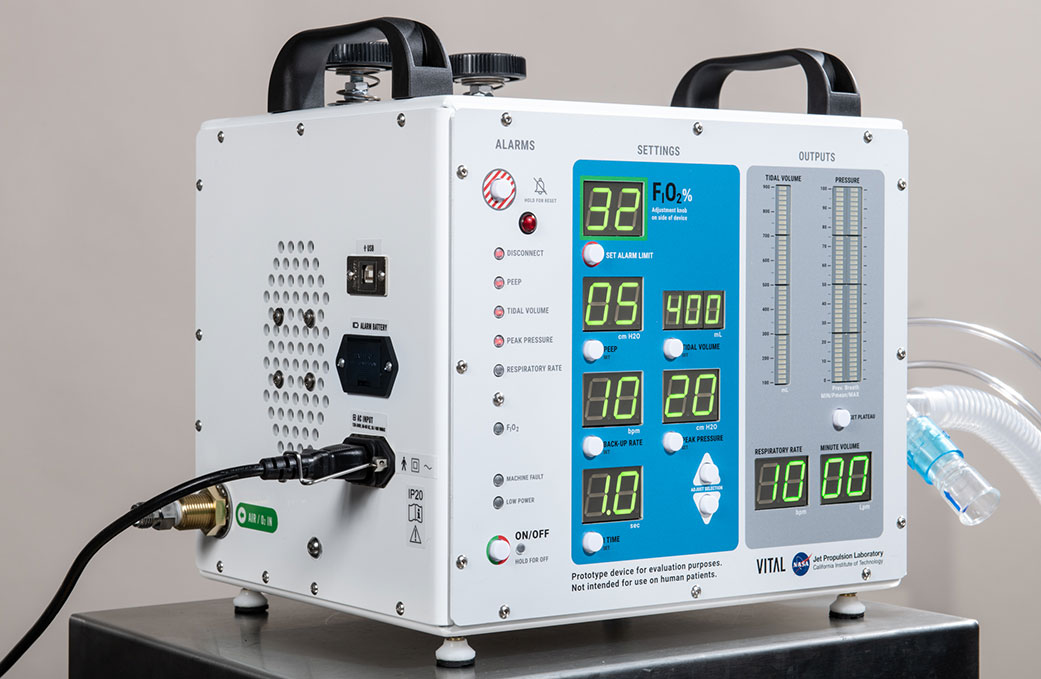
NASA brainpower may soon start making a big difference in the fight against the coronavirus pandemic.
A prototype ventilator built in just 37 days by engineers at NASA's Jet Propulsion Laboratory (JPL) in Pasadena, California, passed a key test this week at the Icahn School of Medicine at Mount Sinai in New York City, agency officials announced Thursday (April 23).
"We specialize in spacecraft, not medical-device manufacturing," JPL director Michael Watkins said in a statement. (JPL is NASA's lead center for robotic planetary exploration.)
"But excellent engineering, rigorous testing and rapid prototyping are some of our specialties," he added. "When people at JPL realized they might have what it takes to support the medical community and the broader community, they felt it was their duty to share their ingenuity, expertise and drive."
Related: Coronavirus outbreak: live updates
The new machine, called VITAL ("Ventilator Intervention Technology Accessible Locally"), can be manufactured quickly, NASA officials said. VITAL also features a flexible design that accommodates use in temporary field hospitals, such as the ones that have sprung up in hotels and convention centers around the world to deal with the crush of patients suffering from COVID-19, the disease caused by the novel coronavirus.
The hardest-hit of those patients end up in respiratory distress, making ventilators a precious resource these days. The need is so acute that companies such as Ford, General Motors, SpaceX and Tesla have assigned some of their smartest engineers to design and develop the breathing machines.
Sign up for the Live Science daily newsletter now
Get the world’s most fascinating discoveries delivered straight to your inbox.
JPL pitched in as well, and its contribution has now been vetted by researchers at Mount Sinai.
"We were very pleased with the results of the testing we performed in our high-fidelity human simulation lab," Matthew Levin, Director of Innovation for the Human Simulation Lab and Associate Professor of Anesthesiology, Preoperative and Pain Medicine, and Genetics and Genomics Sciences at the Icahn School of Medicine, said in the same statement.
"The NASA prototype performed as expected under a wide variety of simulated patient conditions," Levin added. "The team feels confident that the VITAL ventilator will be able to safely ventilate patients suffering from COVID-19 both here in the United States and throughout the world."

VITAL is meant to supplement rather than replace traditional hospital ventilators, which can operate for years and help patients with a variety of ailments. The new device is specifically designed for COVID-19 sufferers and has a planned lifetime of three to four months, NASA officials said.
"Intensive care units are seeing COVID-19 patients who require highly dynamic ventilators," J.D. Polk, NASA's chief health and medical officer, said in the same statement. "The intention with VITAL is to decrease the likelihood patients will get to that advanced stage of the disease and require more advanced ventilator assistance."
NASA is seeking fast-track approval for VITAL from the U.S. Food and Drug Administration. The space agency plans to offer a free license for the new ventilator and is currently reaching out to potential manufacturing partners in the private medical sector.
- NASA's Jet Propulsion Laboratory (JPL): facts & information
- Are ventilators being overused on COVID-19 patients?
- Could genetics explain why some COVID-19 patients fare worse than others?
Mike Wall is the author of "Out There" (Grand Central Publishing, 2018; illustrated by Karl Tate), a book about the search for alien life. Follow him on Twitter @michaeldwall. Follow us on Twitter @Spacedotcom or Facebook.
OFFER: Save 45% on 'All About Space' 'How it Works' and 'All About History'!
For a limited time, you can take out a digital subscription to any of our best-selling science magazines for just $2.38 per month, or 45% off the standard price for the first three months.












